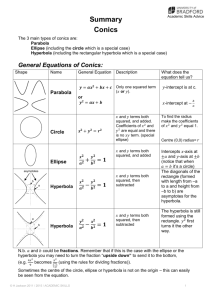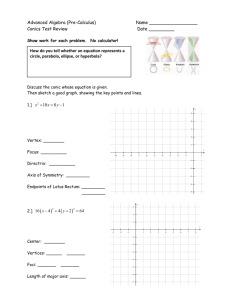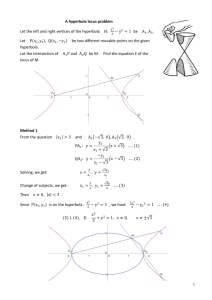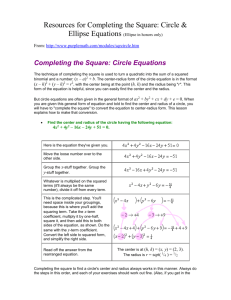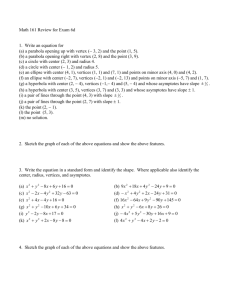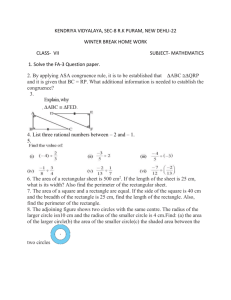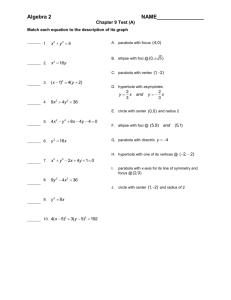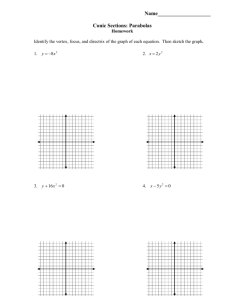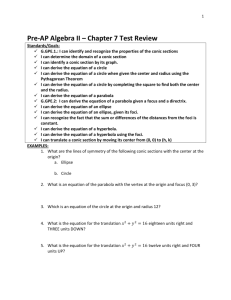conics teaching
advertisement
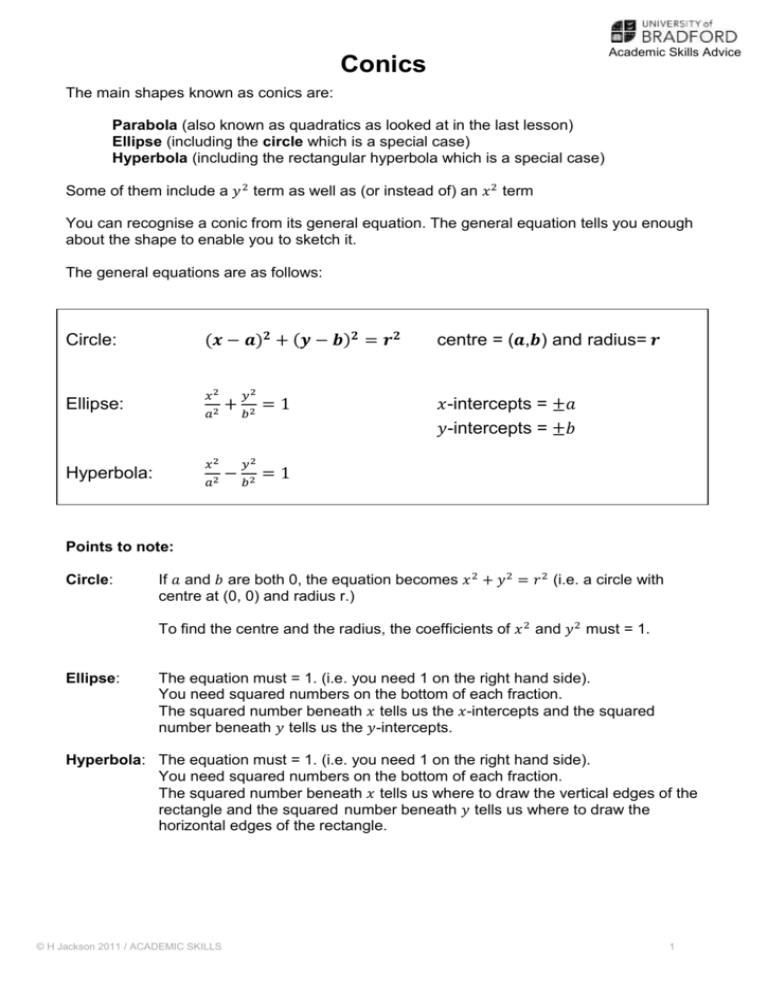
Academic Skills Advice Conics The main shapes known as conics are: Parabola (also known as quadratics as looked at in the last lesson) Ellipse (including the circle which is a special case) Hyperbola (including the rectangular hyperbola which is a special case) Some of them include a 𝑦 2 term as well as (or instead of) an 𝑥 2 term You can recognise a conic from its general equation. The general equation tells you enough about the shape to enable you to sketch it. The general equations are as follows: (𝒙 − 𝒂)𝟐 + (𝒚 − 𝒃)𝟐 = 𝒓𝟐 Circle: Ellipse: Hyperbola: 𝑥2 𝑦2 𝑎 𝑏2 + 2 𝑥2 𝑦2 𝑎 𝑏2 − 2 =1 centre = (𝒂,𝒃) and radius= 𝒓 𝑥-intercepts = ±𝑎 𝑦-intercepts = ±𝑏 =1 Points to note: Circle: If 𝑎 and 𝑏 are both 0, the equation becomes 𝑥 2 + 𝑦 2 = 𝑟 2 (i.e. a circle with centre at (0, 0) and radius r.) To find the centre and the radius, the coefficients of 𝑥 2 and 𝑦 2 must = 1. Ellipse: The equation must = 1. (i.e. you need 1 on the right hand side). You need squared numbers on the bottom of each fraction. The squared number beneath 𝑥 tells us the 𝑥-intercepts and the squared number beneath 𝑦 tells us the 𝑦-intercepts. Hyperbola: The equation must = 1. (i.e. you need 1 on the right hand side). You need squared numbers on the bottom of each fraction. The squared number beneath 𝑥 tells us where to draw the vertical edges of the rectangle and the squared number beneath 𝑦 tells us where to draw the horizontal edges of the rectangle. © H Jackson 2011 / ACADEMIC SKILLS 1 Circle Notice that for a circle: the 𝑥 and 𝑦 terms are both squared, then added. the coefficients of 𝑥 2 and 𝑦 2 are equal there is no 𝑥𝑦 term. (𝒙 − 𝒂)𝟐 + (𝒚 − 𝒃)𝟐 = 𝒓𝟐 centre = (𝒂,𝒃) and radius= 𝒓 Examples: Sketch the circle with equation (𝒙 − 𝟑)𝟐 + (𝒚 + 𝟐)𝟐 = 𝟏𝟔 From the equation we see that the centre of the circle is at (3, −2) and the radius is 4 (because √16 = 4) Notice that the co-ordinates of the centre have the opposite signs to the numbers in the brackets 𝑦 2 𝑥 -1 x (3, −2) Sketch the circle with equation 𝟑𝒙𝟐 + 𝟑𝒚𝟐 = 𝟏𝟐 We need the coefficients of 𝑥 2 and 𝑦 2 to equal 1 so we divide the equation by 3. Starting equation: ÷3: We now have: 3𝑥 2 + 3𝑦 2 = 12 3𝑥 2 3 + 3𝑦 2 3 = 12 3 𝒙 𝟐 + 𝒚𝟐 = 𝟒 Now we can see that the centre of the circle is at (0, 0) and the radius is 2 (𝑎𝑠 √4 = 2) 𝑦 2 -2 2 𝑥 -2 © H Jackson 2011 / ACADEMIC SKILLS 2 Ellipse 𝑥2 𝑎2 + 𝑦2 𝑏2 Notice that for an ellipse: the 𝑥 and 𝑦 terms are both squared, and then added there is no 𝑥𝑦 term. the ellipse intercepts the 𝑥-axis at ±𝑎 and the 𝑦-axis at ±𝑏 =1 (n.b. when 𝑎 = 𝑏 we have a circle). Examples: Sketch the ellipse with equation 𝒙𝟐 𝟗 𝒚𝟐 + 𝟐𝟓 = 𝟏 We need squared numbers on the bottom of each fraction so we let’s rewrite the equation as: 𝑥2 𝑦2 + =1 32 52 It’s now easy to see that the ellipse crosses the 𝑥-axis at ±3 and the 𝑦-axis at ±5 𝑦 5 𝑥 3 −3 −5 Sketch the ellipse with equation 𝟐𝒙𝟐 + 𝟖𝒚𝟐 = 𝟑𝟐 The equation has to equal 1 so we divide the whole equation by 32. 2𝑥 2 32 We now have: 𝒙𝟐 + + 𝟏𝟔 8𝑦 2 32 𝒚𝟐 𝟒 32 = 32 =𝟏 (we can rewrite this as: 𝑥2 42 + 𝑦2 22 = 1) From the equation we see that the ellipse crosses the 𝑥-axis at ±4 and the 𝑦-axis at ±2 𝑦 2 −4 4 𝑥 −2 © H Jackson 2011 / ACADEMIC SKILLS 3 Hyperbola 𝑥 2 𝑦2 − =1 𝑎2 𝑏 2 Notice that for a hyperbola: the 𝑥 and 𝑦 terms are both squared and then subtracted. the diagonals of the rectangle (formed with length from −𝑎 to 𝑎 and height from −𝑏 to 𝑏) are asymptotes for the hyperbola. Examples: Sketch the hyperbola with equation We can rewrite the equation as: 𝑥2 𝒙𝟐 𝟒 − 𝒚𝟐 𝟗 =𝟏 𝑦2 − 32 = 1 22 From the equation we see that we need to draw a rectangle from ±2 along the 𝑥-axis and from ±3 along the 𝑦-axis. We then use the diagonals of the rectangle as asymptotes for the hyperbola. (It might be a good idea to draw the rectangle and it’s diagonals in pencil so you can erase them when you have used them as a guide to draw your hyperbola). 𝑦 3 2 𝑥 Form a rectangle. Use the diagonals as asymptotes. Sketch the hyperbola with equation 𝟖𝒙𝟐 − 𝟐𝒚𝟐 = 𝟖 The equation has to equal 1 so we need to divide the whole equation by 8. 8𝑥 2 8 We now have: − 𝑥2 − 2𝑦 2 8 𝑦2 4 8 =8 We can rewrite this as: =1 𝑥2 12 𝑦2 − 22 = 1 This time draw your rectangle from ±1 along the 𝑥-axis and from ±2 along the 𝑦-axis. 𝑦 2 1 𝑥 © H Jackson 2011 / ACADEMIC SKILLS 4
